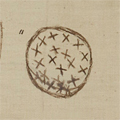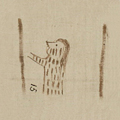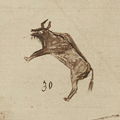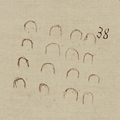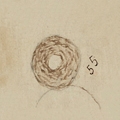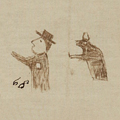Glyph 38 | Year 1860
Šuŋkawakȟaŋ óta áwičakdipi
(Horses many captured-returned-with)
They returned with many captured horses.
The horse became integral to Plains culture when it was brought by the Spanish for use in warfare and traded throughout the western part of North America. They transformed hunting and warfare practices, transportation, lifestyle, wealth and prestige for many Native tribes. Horses are more than a tool for Native peoples, and much like buffalo, are honored through objects, songs, and ceremonies.
Horse raids, or capturing the enemy’s horses, was considered an act of bravery in Plains culture. A warrior's success was displayed by the number of horse shoes often drawn on a shirt, pictographic hide, or muslin. As represented by the glyph, this year was remembered by the community as a year when many horses were taken from another tribe.
Thunder Horse Song
Waŋkátaya tȟokéya ičáǧe ló,
From-up-above the-first instrument it-is-so,
Waŋkátaya tȟokéya ičáǧe ló,
From-up-above the-first instrument it-is-so,
Šúŋka Wakȟáŋ waŋ tȟokáhe keč’úŋ,
Common-animal With-energy [horse] the first even-though,
Maȟpíya ičáǧe, ičáǧe ló.
Cloud instrument, instrument it-is-so.
The Thunder Horse Song is attributed to Mr. Peter Looking Horse (Standing Rock), transcribed by Dakota Goodhouse from a recording of the song:
The song recalls the horse as an instrument that will help them in their lives. It also recalls the appearance of clouds when the horse first appeared, the energy (the energy that is present as with a thunderstorm) of lightening, as in the way Mary Louise Defender-Wilson tells the story, "there was lightning."
— Dakota Goodhouse (Standing Rock)
Elsewhere in the world:
Abraham Lincoln elected the 16th president of the United States

